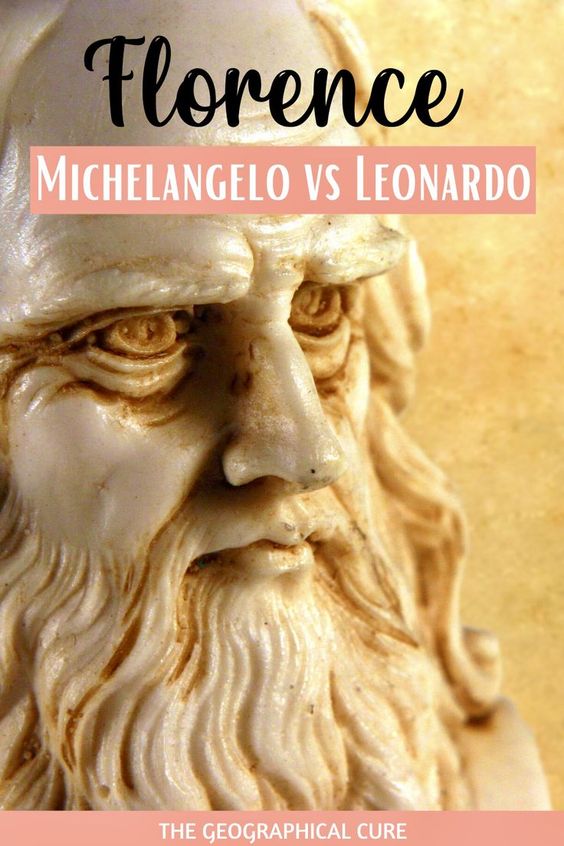In 1505, an epic battle waged between Leonardo da Vinci and Michelangelo at Florence’s Palazzo Vecchio.
At the beginning of the 16th century, Florence was in its great Golden Age. It was a powerful republic and premier city of the Italian Renaissance.
In 1504, Florence found its two greatest artists in the city at the same time. Florence didn’t want to miss this rare opportunity for an artistic showdown. The city decided to have Leonardo and Michelangelo test their talents against each other in the same hall.
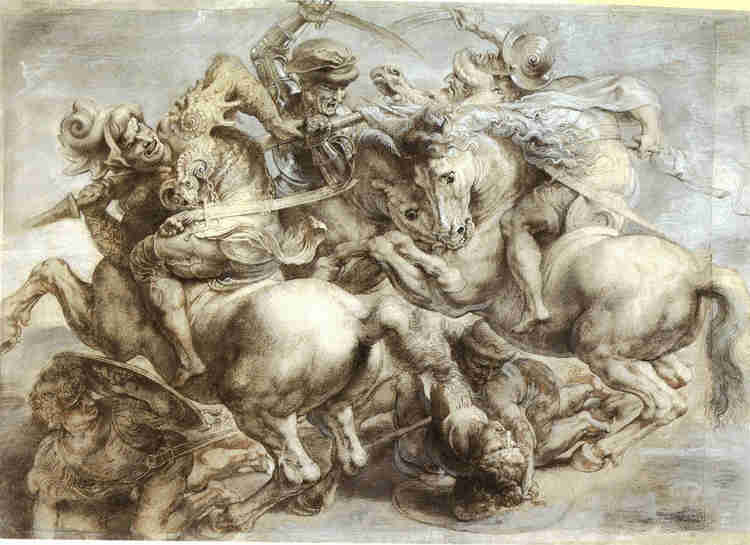
Massive murals were commissioned from each artist for the great Hall of the Five Hundred in Palazzo Vecchio. Both artists were to paint battle scenes, face to face, showing off Florentine military victories.
Leonardo produced a cartoon and actually began to paint. Michelangelo only got as far as producing a large rival cartoon in chalk.
Both cartoons achieved cult status. They were studied and admired by a flock of artists, helping to shape the High Renaissance.
In this guide, you’ll discover how these artists measured up to each other and about the search for the possible lost Leonardo fresco in the Palazzo Vecchio.
exterior facade of the imposing Palazzo Vecchio
The Palazzo Vecchio
The setting for this story is Florence and, in particular, the Palazzo Vecchio.
In 1298, Florentines decided to build a palace to house the governmental entities of the republic. They hired Arnolfo di Cambio, architect of Florence Cathedral and the Basilica of Santa Croce.
In the 16th century, Cosimo I turned the Palazzo Vecchio into the official ducal residence. The palace was then known as the Palazzo della Signoria.
When Cosimo moved across the river to the Pitti Palace, he renamed it Palazzo Vecchio, or old palace. Today, the Palazzo Vecchio still houses the city hall and is a museum.
The Palazzo Vecchio was the setting for key moments in Florence’s history. It was famously the scene of one of Renaissance Florence’s most infamous attempted coups — when the Pazzi family tried to oust the ruling Medici family.
The palazzo was also used by Savonarola, an ascetic Dominican friar who preached the end of the world in passionate sermons. Eventually, Florence (and the pope) grew tired of his theocracy. Savonarola was executed in front of the palace in the Piazza della Signoria.
The palace is thus living breathing history. The entrance is guarded by a copy of Michelangelo’s David and Baccio Bandinelli’s Hercules.
Hall of the Five Hundred
The first floor of the Palazzo Vecchio was for public meetings. It’s dominated by the Hall of the Five Hundred, or the Salone dei Cinquecento. The name derived from the 500 man assembly that met there.
The Hall of Five Hundred is the largest room in Italy built for a palace. Savonarola commissioned it in 1494, when he sought to establish a more democratic government. Consistent with his reforms, Savonarola created the Council of Five Hundred to govern Florence.
Fast forward to the mid 16th century. The still spartan hall was lavishly remodeled by Giorgio Vasari. Vasari was a late Renaissance artist and the world’s first art historian.
In particular, Vasari painted massive frescos depicting the The Battle of Marciano, in which Florence triumphed over rivals Pisa and Siena.
Vasari also painted the 39 gilded ceiling panels, telling the life story of Cosimo I.
The Artists: Leonardo and Michelangelo
But before Vasari, there was Leonardo and Michelangelo.
Leonardo
The ultra intelligent and charming Leonardo was a towering figure of the Renaissance, a maestro of change who married imagination to the universe. History’s consummate innovator, Leonardo was enviably good at everything, perhaps the most relentlessly curious human in history.
In fact, Leonardo cared more about knowledge and science for its own sake than he did about fame and fortune. His prodigious talent, while well recognized then, is more revered posthumously.
Leonardo was considered the quintessential “Renaissance man” — a painter, polymath, scientist, astronomer, architect, anatomist, stage set designer, and engineer. He was often spread too thin and left works incomplete, perhaps due in part to perfectionism. But Leonardo left a long-lasting legacy of visual realism, invention, and mystery.
Though he’s most famous for the Mona Lisa, it wasn’t really his best painting. That was probably The Last Supper, his famous fresco that you can visit in Milan.
READ: Guide To Visiting Leonardo’s The Last Supper
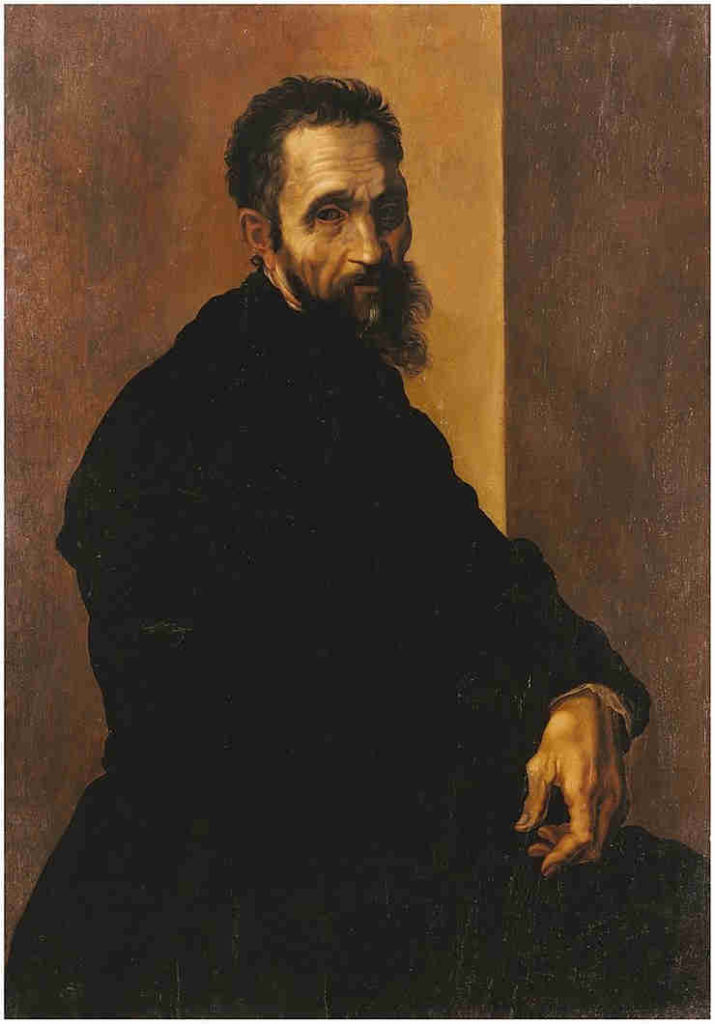
Michelangelo
Michelangelo was the anti-Leonardo. He was a brooding, aloof, and sometimes cantankerous fellow. Michelangelo was arrogant and yet paradoxically hypersensitive. He refused to compromise on his art.
Michelangelo was also a tireless workaholic. He rarely bathed, as if he couldn’t bear any time away from his beloved marble and paint. Legend holds that his dirty clothes and boots had to be cut off him when he died.
Nicknamed Il Divino, Michelangelo created some of the world’s most beautiful and revolutionary art.
He was a master at creating idealized, technically perfect visions of the human body. Psychological and physical realism had never been portrayed with such panache.
The Painting Wars
1. Artistic Rivalry in the Palazzo Vecchio
Leonardo and Michelangelo weren’t friends, even remotely. There was a generational gap of 23 years, with Leonardo being the elder. The artists were total opposites — utterly different in their use medium, aesthetic philosophy, and personality.
A handsome Leonardo was a charmer and social butterfly, who opened his studio to others. Michelangelo was secretive and neurotic, worked in isolation, and was prone to violent rages.
They were intensely competitive and criticized each other’s work. At stake? They both wanted to be the supreme artist of Italy.
Leonardo dismissed Michelangelo as a neophyte, criticizing his contorted and muscular male nudes. Michelangelo mocked Leonardo for failing to render his equestrian statue in bronze in Milan.
Leonardo was the first to arrive back in Florence. He was heralded for his success in Milan with The Last Supper. Michelangelo was already famous, an up and coming sculptor who had only recently unveiled his David sculpture.
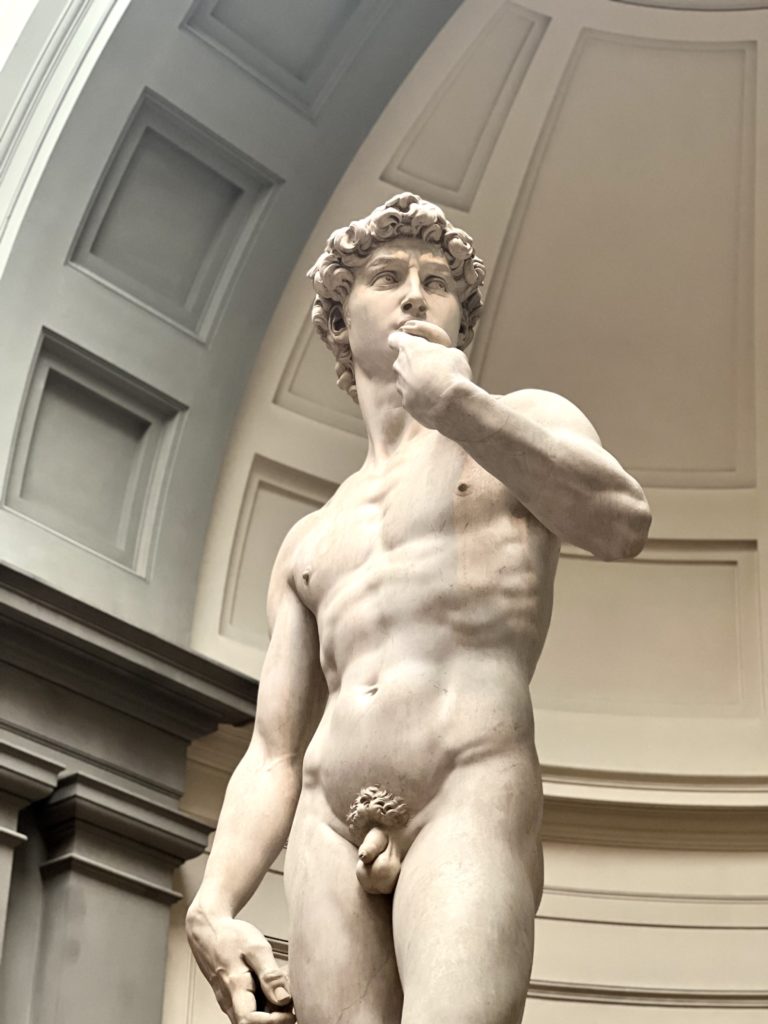
The city council, specifically Piero Soderini, shrewdly wanted both artists to simultaneously paint the walls of the great hall. He intentionally pitted them against each other.
Soderini hoped the informal competition would inspire each artist to great heights and, for Leonardo at least, to finish the project. At the time, it was seen as a direct head to head competition.
The people of Florence were filled with anticipation and civic pride for the embellishment of the Hall of the Five Hundred. The frescos were intended to exalt the virtues of the Republic.
The council wanted battle scenes. Why? Battle scenes had become fashionable in the Renaissance. Battles also offers artists interested in anatomy a chance to exercise their skills. They were considered key works of the era.
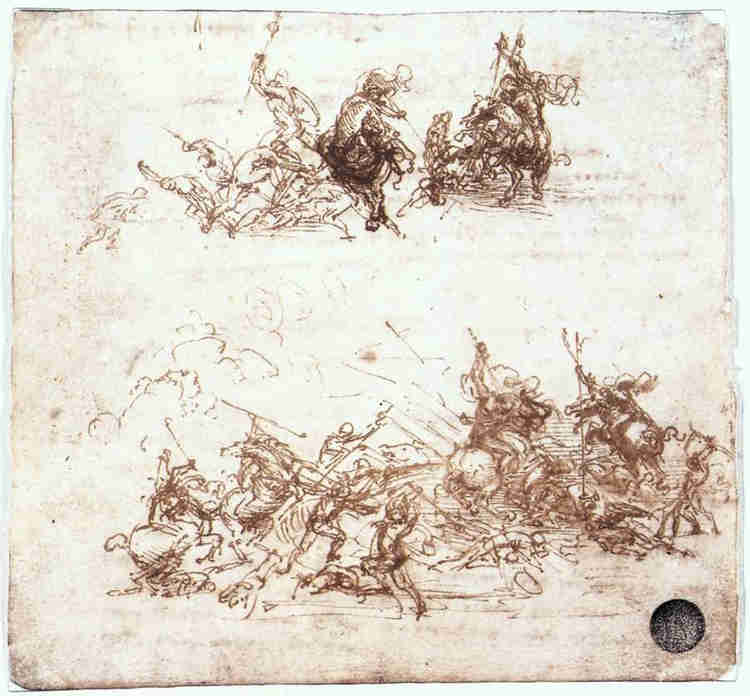
2. Leonardo’s Battle of Anghiari Fresco
In 1503, the City Council commissioned Leonardo to paint a massive fresco (270 feet long). It was intended to celebrate Florence’s victory in 1440 over Milan in the Battle of Anghiari.
Leonardo created a large cartoon of the Capture of the Standard with horses and riders in frenzy, fighting to the death. Contemporaries agreed that no one could equal Leonardo’s ability to draw a horse. The cartoon, however, is long lost.
Based on historical evidence and chroniclers, it’s generally believe that Leonardo began to paint the 15 x 20 central panel in 1505. Leonardo even made a unique machine, a wooden elevator enabling him to move up and down the wall in comfort.
Unfortunately, Leonardo experimented with paint (adding wax), as he had with The Last Supper. And he used braziers to increase drying speed, which made the paint drip on the lower portion of the fresco. It was a melting masterpiece.
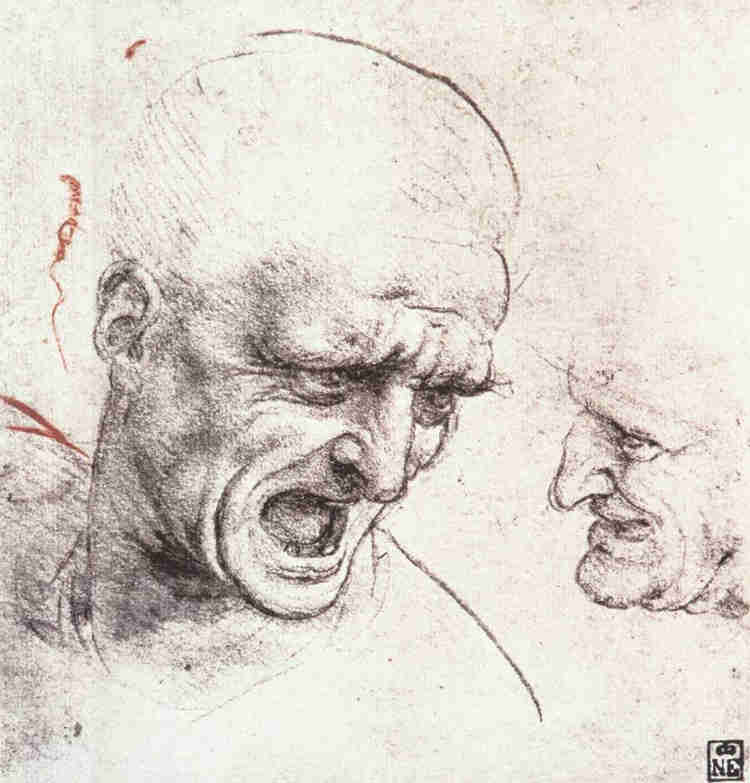
Frustrated by the failed experiment, Leonardo abandoned the project and decamped to Milan. (As he frequently did with commissions.)
The Battle of Anghiari was displayed for several years in the Palazzo Vecchio. The fresco was hailed as a “miraculous” and unprecedented study of anatomy and motion.
People came to admire it. Other Renaissance artists thought it was Leonardo’s best work yet and made copies.
There’s a polished version by Peter Paul Rubens in the Louvre. It’s possible that Rubens saw the actual fresco in the Palazzo Vecchio.
There’s also a preparatory sketch by Leonardo himself in Venice’s Galleria dell’Accademia You can see he was trying to figure out how to compose the complicated scene and capture the animated figures in action. There are other Leonardo sketches on display in London, Vienna, and Budapest.
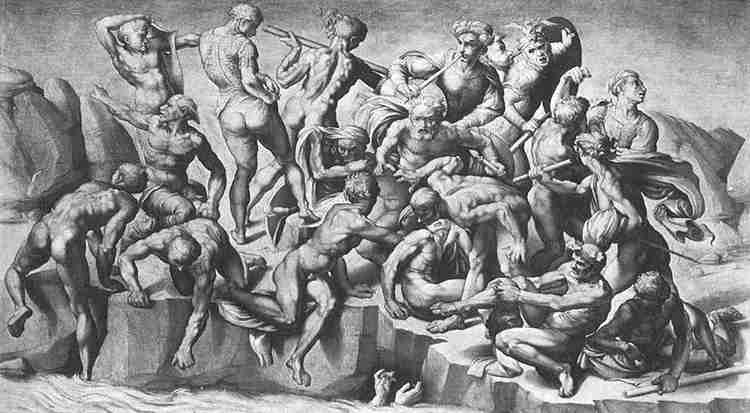
3. Michelangelo’s Battle of Cascina Fresco
Michelangelo was also in town. In 1504, the city council commissioned the 29 year old to paint the Battle of Cascina, as a companion piece to Leonardo’s work. It was meant to depict the battles between Florence and Pisa. It’s unclear whether Michelangelo was supposed to paint on the same or opposite wall as Leonardo.
Michelangelo had previously tried to sculpt a battle scene when he was in the court of the Medici, The Battle of the Lapiths and Centaurs. This relief is now in Florence’s Casa Buonarotti.
When Michelangelo took the contract to paint in Palazzo Vecchio, he was already famous. He had completed the Pieta and David. He wasn’t yet at the height of his powers, since the Sistine Chapel was yet to come. But, to Leonardo, he was a threat.
It was a well-known that Leonardo was working on a group of soldiers and horses for his Battle of Anghiari. Michelangelo intentionally chose a different way to depict his battle. He chose to portray nothing but nude figures.
Michelangelo was given a massive room in a convent to work in. He was asked to produce a cartoon, which no longer survives. Michelangelo never got past the drawing stage.
In typical Michelangelo fashion, the artist used the battle motif to showcase his favorite subject, the male nude in a number of poses. The episode in the cartoon was set the day before the battle. It showed soldiers scrambling to get dressed, panic on their faces after the sound of alarm.
Presumably, Michelangelo never got around to producing the other episodes from the battle.
But his cartoon, left on display, was still considered an astonishingly beautiful drawing.
It caused a sensation because of his dynamic portrayal of over life size figures in action. Vasari and the sculptor Cellini described it as “The School of the World,” something which all artists should see and strive to emulate.
Michelangelo’s cartoon became an artistic pilgrimage. Artists visited, admired, and (sadly) tore off pieces of the cartoon as a sacred relic. Little by little, the cartoon disappeared.
But there is a reproduction of one episode from that battle (shown above) drawn by Michelangelo’s friend Aristotele de Sangallo. It gives you a sense of Michelangelo’s battle cartoon.
Some of Michelangelo’s preparatory sketches also exist, several in Florence’s Uffizi Gallery. Michelangelo composed figures solo to determine how they would fit in the overall cartoon.
Michelangelo never began painting the fresco. Why? Because he got an urgent message from the newly elected Pope Julius II. He was commissioned to build a tomb for the pope in Rome. This project then led to the Sistine Chapel commission.
Search for the Lost Leonardo
So both artists abandoned the project. Nothing remains of their finished battle cartoons, which shaped a generation of painters. But what about Leonardo’s semi-botched central panel fresco?
1. Vasari’s Battle of Marciano Fresco and Possible Intervention
Fifty years later, in 1563, Giorgio Vasari was commissioned to repaint walls left unfinished by Leonardo and Michelangelo. He covered them with frescoes of military victories by the Medicis, who had returned to power.
The result was rather uninspired. Vasari was a vivid writer, but a rather flat painter. This isn’t one of Florence’s greatest masterpieces.
Vasari was a great admirer of both artists. Some scholars believe that behind Vasari’s frescos lies the long lost Battle of Anghiari. What happened to it?
Legend holds that, instead of painting over Leonardo’s unfinished work, Vasari built a false wall over the fresco to preserve it. Then, he painted The Battle of Marciano on the false wall.
Vasari even left a cryptic clue. On a flag on his fresco way in the back, he wrote the phrase “He who looks will find.” Only 15-16 known Leonardo’s exist, making this possibility tantalizing.
In fact, Vasari did this again in 1570. While working in the Church of Santa Maria Novella, Vasari preserved early Renaissance painter Masaccio’s The Holy Trinity in the same way. He built a thin wall in front of the Masaccio painting and then put his own tabernacle in front. The Masaccio painting was discovered in the 18th century.
2. Discovery of a Possible Hidden Painting
At this point, enter Maurizio Seracini, a biomedical engineer. He had been looking for Leonardo’s Battle of Anghiari for 50 years without success. But technology advanced.
In 2012, Seracini laser mapped the room, finding the exact location of the prior Leonardo work. Seracini got permission to drill tiny holes through cracks in the wall housing Vasari’s work. He used an endoscopic camera and probe.
He drilled through portions of the fresco that had not been completed by Vasari himself but by his workshop. Since it wasn’t an original Vasari, it should have been just fine to look for the Leonardo.
Seracini found an air gap behind a portion of Vasari’s painting. No other gaps exist behind other parts of the fresco.
He also found a painting on the wall behind the Vasari fresco. Traces of black pigment that matched Leonardo’s Battle of Anghiari were found. Leonardo had also used this same pigment in many paintings. But, to be fair, so had other artists.
The project was backed by the National Geographic Society and had the support of the mayor of Florence, Matteo Renzi.
Vasari clue, which translates as “He who looks will find.”
3. Project Shut Down
But then a hew and cry began. Some art historians didn’t want the precious Vasari frescos, recently restored, to be damaged in any way.
The project was shut down. Nothing has happened since 2012, despite proof of a painting being there.
There is also debate over what would happen if Leonardo’s fresco was actually discovered. What would they do? Tear down Vasari’s wall? Or is there a technology that would prevent damage from separating the images?
For the time being, one of the greatest mysteries of the art world remains unsolved. There are so few Leonardo paintings. If historians ever successfully located the lost Leonardo, the find will likely have a significant impact on art history.
No one knows what shape the painting will be in. But, having been covered up, it was protected against the environment, vandalism, and bad restorations.
Florence’s mayor still remains interested in discovering the mysterious lost Leonardo. Is the search dead in the water? Stay tuned …
I hope you’ve enjoyed my guide to the dueling battle frescos in the Palazzo Vecchio. You may enjoy these other Florence travel guides and resources:
- 1 day itinerary for Florence
- 2 day itinerary for Florence
- 3 day itinerary for Florence
- Best museums in Florence
- Hidden gems in Florence
- Must see sites in Florence
- Florence art bucket list
- Best day trips from Florence
- Guide to the Medici Palaces
Pin it for later.
